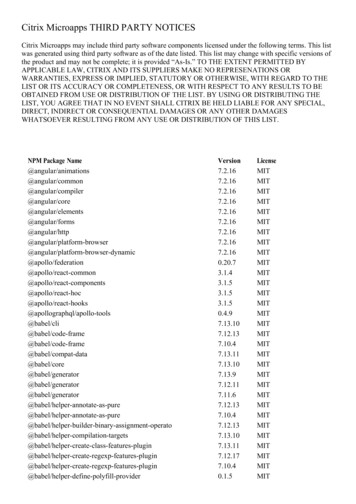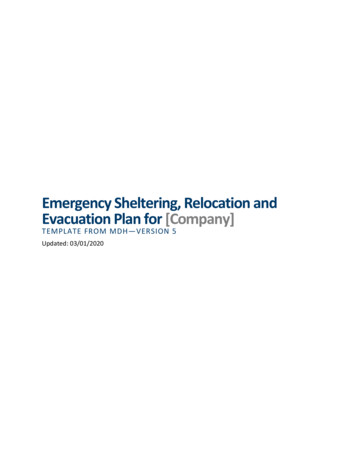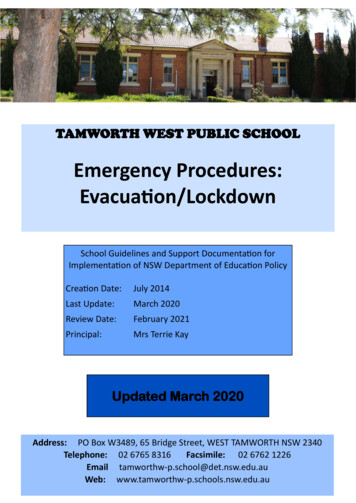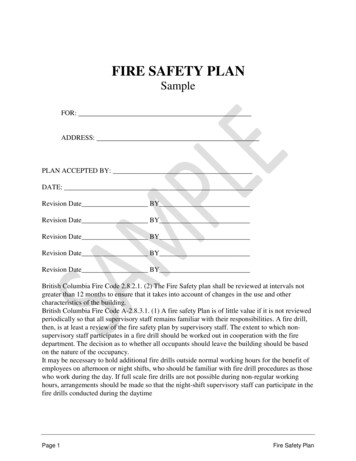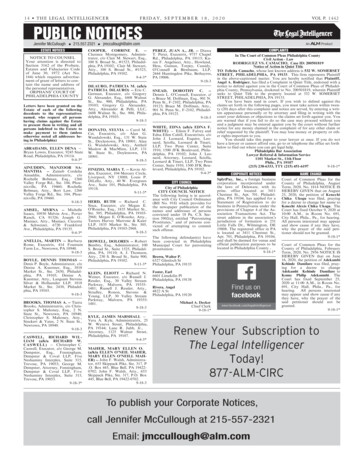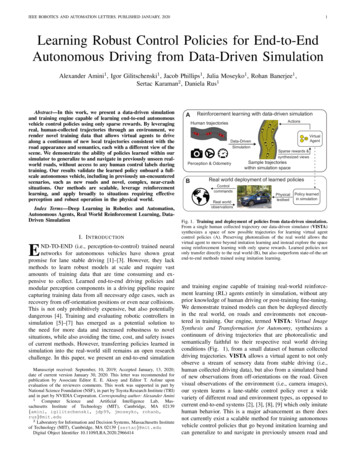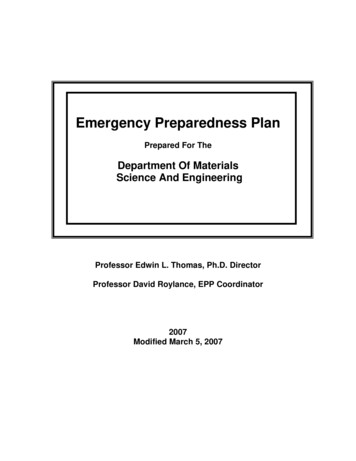
Transcription
Emergency Preparedness PlanPrepared For TheDepartment Of MaterialsScience And EngineeringProfessor Edwin L. Thomas, Ph.D. DirectorProfessor David Roylance, EPP Coordinator2007Modified March 5, 2007
DMSE EMERGENCY PREPAREDNESS PLANEVACUATION PLANI. Fire Alarm. 1II. Emergency Phone Number. 1III. Personnel With Delayed Evacuation Permission. 1IV. Responsibility For Communicating Emergencies . 1Fire. 1Other Emergencies . 1V. Personnel Who Will Fight Incipient Fires . 2VI. Evacuation Procedures . 2General Procedure In The Event Of Fire . 2Evacuation Of Persons With Disabilities . 4Evacuation In The Event Of A Bomb Threat . 4Evacuation In The Event Of An Explosion . 4VII. Rescue Assignments. 5Personnel Assigned Specific Rescue Assignments . 5VIII.First Aid . 6ORGANIZATION AND RESPONSIBILITYI. Organization . 7II. People . 7III. Operations . 7IV. Responsibility . 9Fire Marshals . 9Duties Of The Fire Marshall . 10Fire Wardens . 11The Duties Of The Fire Wardens . 12V. Utilities Maintenance - Emergency & Routine. 13For All Emergencies. 13To Request Repairs. 13
FIRE PREVENTION PLANI. Requirements . 14II. Identification of Fire Hazards . 14III. Housekeeping ProceduresHazardous Waste Pick-Up. 15Fire Protection Equipment. 15Inspection of Fire Extinguishers and Fire Hoses . 15Monthly Inspection of Fire Extinguishers Sheet. 16Monthly Inspection of Fire Hoses Sheet. 16SHELTER IN PLACE. 17GRAPHICSMeeting AreaBuildings 4, 8, 12, 16. 21Floor Plans4.0 . 254.1 . 264.2 . 274.4 . 288.0 . 298.1 . 308.2 . 318.3 . 328.4 . 3312.0 . 3416.5 . 3516.6 . 36
EVACUATION PLANDepartment of Materials Science And EngineeringHeadquarters 35-419(617) 253-33002007I. FIRE ALARMA. To activate a fire alarm box in building 4, 8, 12, 16 pull down the handle.This is the preferred method because:a. The alarm alerts others.b. It alerts the Work Control Center (Operations) as to the location of the box sothey may better direct the Cambridge Fire Department.c. It brings the Cambridge Fire Department, MIT Police Department and theEmergency Response Team to the location.d. There is less chance of confusion that could result from a telephone call.B. The fire alarm in building 4 is a Sloop Whoop with no pretone or evacuationmessage. Building 8 alarm is Temporal Three with pretone and non high rise voiceevacuation message. Building 12 alarm is a Sloop Whoop with pretone and non highrise voice evacuation message. Building 16 alarm is a Sloop Whoop with pretone andnon High rise voice evacuation message.II. EMERGENCY PHONE NUMBER:DIAL 100If there is no fire alarm box nearby, dial 100. Give your name, location and a descriptionof the problem. Speak slowly and clearly. Wait to answer any questions or receiveinstructions the dispatcher may have. Stay on the line until the dispatcher hangs up.III. PERSONNEL WITH DELAYED EVACUATION PERMISSIONThe Institute policy is to evacuate immediately when an alarm is sounded. TheDepartment of Materials Science And Engineering does not have personnel whom maydelay evacuation.IV. RESPONSIBILITY FOR COMMUNICATING EMERGENCIESA. FIREAll staff has the responsibility of communicating the initial alarm.MIT Police Department will be relied on to check all floors when deemed necessaryby the Cambridge Fire Department.It may be necessary to actuate additional fire alarm boxes if people are still in thebuilding and the alarm has stopped ringing.B. OTHER EMERGENCIESMIT DMSE Emergency Preparedness PlanPage 1
To report all other emergencies including medical police, explosions and other accidentsdial 100. State your name, location and the nature of the emergency. Speak slowly and clearly.Wait for the dispatcher to hang up first. On occasionthey may need additionalinformation or will provide you with some instructions.V.TRAINED PERSONNEL WHO WILL FIGHT INCIPIENT FIRESThe Institute policy is to evacuate immediately, NOT to fight fires. Fire fighting shouldonly be done by trained personnel.VI. EVACUATION PROCEDURESA. GENERAL PROCEDURE IN THE EVENT OF FIRE1. WHEN AN ALARM SOUNDS:a) Do not stop for valuables or to get a coat.b) If possible to complete safety as you leave: Shut off electrical appliances. Leave lights on Close doors and windowse) If you lock your door, take your keys with you.f) Alert others around you.g) Assist any special needs people in evacuating.h) When evacuating WALK, never run, and keep to the right of thehallways.i) Leave the building, even if the alarm stops while you are on your wayout.DO NOT USE ELEVATORS.j) Once outside, move away from the building to allow room for thefirefighters and their equipment.Building 4 occupants should proceed to Killian Court. Duringinclement weather go to Lobby of Bldg.10. Building 8 occupants shouldproceed to Eastman Court. During inclement weather go to the Lobby ofBldg. 10. Building 12 occupants should gather by the North side ofbuilding 13. During inclement weather go to the Lobby of Bldg. 13.Building 16 occupants should proceed to Killian Court. Duringinclement weather go to Lobby of Bldg.26Look for others who work with you to insure everyone has evacuated.k) Give any information about the fire or about persons who might still bein the building to your Fire Warden, the Fire Department, MITEmergency Response Team or MIT Police Department.MIT DMSE Emergency Preparedness PlanPage 2
l) Do not re-enter the building for any reason until told to do so by the FireDepartment or MIT Police Department.2. IF YOU CANNOT LEAVE BECAUSE ALL EXITS ARE OBSTRUCTEDa) Crawl or stay low to the floor where there is cleaner and cooler air.b) Get to a phone, dial 100 and let someone know where you are.3.OF PARTICULAR IMPORTANCEa) Keep calm. A fire may be hot, noisy, and generally overwhelming, butyour best weapon is a composed and logical approach.b) Assume there is a fire when the alarm sounds. Take it seriously.c) Do not call MIT Police Department or Dept. Of Facilities to ascertainif there is a real fire.d) Do not use the elevator. The shaft may act like a chimney, and the carmay stop at the fire itself. Elevators may also act like giant pistons,pushing smoke and fire to other portions of the building. Usethenearest exit stairway or passageways to an adjacent building.e) Do not run if your clothes catch fire. Running will only fan the fire,causing it to intensify. Drop to the floor and roll back and forth tosmother the flames. Call for help. Rescuers can smother the flames byquickly wrapping a blanket, coat, sheet or rug over the victim.f) Leave the building. This includes lobby areas. Not doing so isconsidered interference with fire fighting operations and violators of thisMassachusetts State Law are subject to a fine, imprisonment, or both.4.OTHER CONSIDERATIONSa) Exiting horizontally Horizontal evacuation generally means to moveon the same floor to another section in the same building or an adjacentbuilding instead of exiting vertically via the stairs or elevator. Theadvantage to horizontal evacuation is that one may remain inside,protected from the weather and avoid descending over stairs. Hence, thismethod is of primary importance for people with disabilities.For horizontal evacuation to be effective, one must pass though smokebarriers and/or fire barriers. Usually this means smoke or fire doors orperhaps a fire wall. The terms fire doors and smoke doors are reallysynonymous except a fire door can withstand a fire and prevent itspassage more effectively because of heavier construction materials and aheftier frame. Smoke doors and their frames are comparatively morelightly constructed and cannot withstand a rigorous fire for as long aperiod as a fire door. Both, however, will keep deadly smoke and fireconfined long enough to make an escape or rescue possible providedthey are kept closed. Doors blockedopen with wedges, broken orimproperly working doors, a fire hose or other object holding the dooreven a little is enough to render the designed safety effect of preventingthe spread of smoke and fire useless.MIT DMSE Emergency Preparedness PlanPage 3
It is important to note when evacuating horizontally that it is not enoughmerely to exit into an adjoining building. It is necessary to go beyondan operating fire or smoke barrier.B.EVACUATION OF PERSONS WITH DISABILITIESWe will use horizontal evacuation whenever possible. Refer to floor plans forpossible routes.If horizontal evacuation is not possible, staff will assist disabled individuals to thenearest enclosed stairway that is free from smoke and tell the person to remainthere until help arrives (Fire Department, MIT Police Department, etc.). Ifpossible, we will send someone to dial 100 to inform MIT Police Department ofthe stairway and floor location.C.EVACUATION IN THE EVENT OF A BOMB THREATEvacuation procedures are the same as fire evacuation procedures except it ispermissible to use elevators to evacuate. The elevators, however, should bereserved primarily for those who are disabled, elderly, pregnant, have heart orrespiratory conditions, or other medical problems. Others should exit via thestairwells to expedite evacuation. Please follow the directions of supervisorypersonnel during this situation.NOTE:The handling of explosives is a job strictly for professionals. Should you noticesomething you suspect may be a bomb because it is an unusual item in an areayou are very familiar with, do NOT touch it! Report it to the MIT PoliceDepartment, Emergency Response personnel, or Fire Department personnel. Beprepared to describe the item and its location.D.EVACUATION IN THE EVENT OF AN EXPLOSIONIn the event that an explosion occurs, use the Fire Evacuation Procedure.MIT DMSE Emergency Preparedness PlanPage 4
VII.RESCUE ASSIGNMENTSSome personnel may be assigned to limited preplanned rescue duties. No one is expectedto be a rescue expert. Minimum rescue duties include aiding the disabled with evacuation andassuring everyone is alerted to the need for evacuation if they can be done without injury orsignificant danger to the rescuer. We will preplan with the MIT Disabilities Services Office andthe MIT Safety Program for the evaluation of disabled students or employees. Otherwise,inform the Fire Department of the location of trapped persons and anyone who is unaccountedfor.PERSONNEL ASSIGNED SPECIFIC RESCUE ASSIGNMENTSAt this time there are no individuals requiring assistance to leave DMSE space.When individuals requiring assistance to evacuate DMSE space arrive, the Lab in which thisperson is located MUST inform DMSE Headquarters and ASSIGN A PERSON whoseassignment will be to assist the disabled person(s) entry into a secure area such as a stairwell tillhelp arrives. The names of these individuals will be entered below as needed.The escort should remain with this person. The Warden from the Lab the handicapped personworks should tell the Floor Fire Marshall the location of the handicapped individual.LabEscortRoomPhoneEmailNone required atthis time.Visitors to DMSE space must be assigned a person who will assist with their evacuation from thebuilding.MIT DMSE Emergency Preparedness PlanPage 5
VIII. FIRST AIDThere are no first aid kits in the Department of Materials Science And Engineering.Medical personnel already assigned to the MIT Campus community such as the MedicalDepartment, MIT Police Department and Emergency Medical Technicians satisfy therequirements of OSHA regulations 1910, Subpart K. These trained and skilled personnel can berequested via telephone (Dial 100) or through emergency personnel. Those who are trained toassist the injured may aid the wounded only within the scope of their training and on a voluntarybasis.NameMIT Medical Dept.MIT Police DepartmentSEMS (Student EmergencyMedical Service)Type & Extent of TrainingProfessional doctors, nurses, etc.Certified EMT’sCertified EMT’sMIT DMSE Emergency Preparedness PlanPage 6
ORGANIZATION AND RESPONSIBILITYDepartment of Materials Science And EngineeringHeadquarters 35-419(617) 253-33002007Location: Building 8, Room 309(Note: DMSE occupies some or all of the following floors:Building 4 - Basement, First, Second, Fourth floors.Building 8 -Basement, First, Second, Third floors.Building 12 – Basement floor.Building 16 – Fifth, Sixth floor.Building NE47 – Third FloorDMSE DirectorProf. Edwin L Thomas, PhD35-412(617)253-5931EH&S CoordinatorJoseph A. Glogowski, Jr.35-405(617)253-5632EPP CoordinatorProf. David Roylance, PhD6-20226-441(617)253-3309(617)258-6275Total Number of People:Employees:169Graduate Students :220Visiting Scientists: 8Students: 110Affiliates: 21Visitors: 10OPERATIONS1.Interests within the Department span the entire materials cycle from mining and refiningof raw materials, to production and utilization of finished materials, and finally todisposal and recycling. There is a rich variety of problems of vital importance to thedevelopment of the science of metals, polymers, ceramics, glasses, electronic materials,biomedical materials, composites, and other materials awaiting solution. The Departmenthas the theoretical and experimental resources available to attack these scientific andengineering problems successfully.2.There are hazardous materials and equipment involved.3.Hours and Days of Operation:Normally Monday-Friday9:00 a.m. - 5:00 p.m.These hours may vary depending on research requirements.People working outside of regular working hours must leave the building during anemergency and are instructed to follow the instructions of any responding emergencypersonnel.MIT DMSE Emergency Preparedness PlanPage 7
4.There are no guards or night watchmen in buildings 8. Police protection is provided byMIT Police Department.MIT DMSE Emergency Preparedness PlanPage 8
DMSE Fire MarshalsFloorLabFire MarshallRoomPhoneBld 4EagarGaller, Donald4-133(617)253-4554Bld 8UGTLNanoBono, David CSchwartzman8-1114(617)452-3837Bld 12CimaCentorino, John ARigione, Leonard J12-02412-096(617)253-5034(617)253-4049Bld 16LechtmanLechtman, HeatherN8-437(617)253-2172MIT DMSE Emergency Preparedness PlanPage 9
DUTIES OF THE FIRE MARSHALL1. To coordinate, instruct, and familiarize Fire Wardens in fire evacuation proceduresand related tasks.2. To convey applicable information to one or more of the following:Fire Department personnel, MIT’s Emergency Response Team and MIT PoliceDepartment3. A Fire Marshal will usually be assigned an entire floor, wing or area directing andcoordinating the Fire Wardens in his/her area. If a Fire Marshal is absent, analternate should assume these duties.4. On Floors with more than one Lab, each labs EHS Representative with assume theresponsibilities of Fire Marshall for one year. They will rotate in alphabetical order,by Lab.MIT DMSE Emergency Preparedness PlanPage 10
DMSE Fire WardensLabLoc4(0)PI NameEHs RepRoomPhoneEmailAllen, Samuel MTarkanian, Michael4-010tarky@mit.edu4(0)O'Handley, Robert C Techapiesancharoenkij, Ratcha 4-0514(0)Powell IV, Adam C(617)2535946(617)4524698(617)452-4(0)Sadoway, Donald R4(0)VanderSande, JohnBEagar, Thomas W4(0,1)Powell IV, Adam C4-117Avery, Kenneth CharlesGmitter, Andrew JRichter, Henning66-270Galler, Donald4-1334-2294(1)Gibson, Lorna JGaller, Donald4-1338(0)Allen, Samuel MTarkanian, Michael4-0108(0,1)Suresh, SubraLa Bonte Jr, George J8(0,4)Schuh, ChristopherDetor, Andrew JosephTrelewicz, JasonRuan, Shiyun8(1)Gibson, Lorna JDawson, Matthew A8(1)Ross, Caroline ASivakumar, Vikram8(1)Stellacci, FrancescoBono, David C8(1)Van Vliet, Krystyn JSchwartzman, Alan F8(2)Ortiz, ChristineBono, David C8(2)Van Vliet, Krystyn JThompson, Michael Todd8(2,4)Irvine, Darrell JBeane, Sheree Michelle8(3)Allen, Samuel MHughes, Gerald8(4)Lechtman, Heather N Lechtman, Heather N12(0)Cima, Michael J12(0)Kimerling, Lionel CCentorino, John ARigione, Leonard JBeals, Mark12(0)Ortiz, ChristineYe, Miao16(5)Lechtman, Heather N Lechtman, Heather N16(6)Gibson, Lorna J16(6)Lechtman, Heather N Merrick, Harry VCorin, Karolina APage 4554(617)2534554(617)253-dgaller@mit.edu59468-139M 17)2538-102529913-4017 8-30939388-437(617)253217212-024 (617)25312-096 503412-064 (617)253212912-065 )2538-4366087MIT DMSE Emergency Preparedness lan edubharley@mit.eduhmerrick@mit.edu
THE DUTIES OF THE FIRE WARDENSBefore a fire occurs:1.2.3.4.To familiarize new employees and students with fire evacuation procedures.To assist persons with disabilities with evacuation pre-planning, drills andactual evacuations.To note any malfunctioning alarms.To discourage tampering with fire alarm and protection equipment.During a fire:1.To remind people in their area that if possible they should close windows anddoors, shut off equipment (if necessary) and to evacuate. To note thelocation(s) of fire and/or smoke if seen, but not to search for it.2.To note the location(s) of fire and/or smoke if seen, but not to search for it.Additional suggested assignments:1.Monthly visual checks of fire protection equipment.2.Participate in fire alarm tests.3.Set up an annual fire evacuation drill (contact the Safety Program).A Fire Warden is usually assigned a floor or a section of the respective area in which they work.If the Fire Warden is absent, the duties would be performed by the alternate.For Further Information Concerning Employee Duties and ResponsibilitiesThe following names or regular job titles of persons or departments that can becontacted for further information or explanation of duties under the plan are:a.b.c.d.Fire Wardens/Fire MarshalEPP CoordinatorsSupervisors/Department ManagementSafety Program – N52 x2-3477 safety@mit.edu*Refer to previous listsMIT DMSE Emergency Preparedness PlanPage 12***
Utilities Maintenance - Emergency & RoutineFor all emergencies call extension 3-4948 or Operations Center at 3-1500To request repairs via internet use the following:https://web.mit.edu/facilities/forms secure/repair-form.shtmlMIT DMSE Emergency Preparedness PlanPage 13
FIRE PREVENTION PLANDepartment of Materials Science And EngineeringHeadquarters 8-309(617) 253-330020071.RequirementsOSHA requires a written Fire Prevention Plan that is to be kept in theworkplace andis available to employees. The DMSE must alsoreview with each new employee, theparts of the fire prevention plan that the employee needs to know to protect him/herself. Thiscan be included in the DMSE’s safety briefing.2. The Identification of Operations that are Fire Hazards and the Handling,Disposal of Materials that Present Fire Hazards.Storage, andAll employees and students should recognize hazards and report these tothe supervisorso corrective action may be taken. The identification, properhandling, and storage ofhazardous materials is the responsibility of the DMSE’s management and the principalinvestigator or supervisor.It would be impossible to list all the possible fire hazards you may encounter, however,the ones you are most likely to encounter whileworking in the DMSE are listedbelow.a.b.Common Fire HazardsControls areSources areelectrical appliancesand equipmentthe proper use andmaintenance of elec.equipmentoverheating,sparks andelectrical arcingThe procedure for hazardous operations or materials to minimize fire hazardsare as follows:Ignition SourcesControl Procedures(1) electrical appliances that produce heatdo not operate unattended ornear combustibles(2) overloaded electrical extension cordsinstall more electrical outletsMIT DMSE Emergency Preparedness PlanPage 14
FIRE RELATED HOUSEKEEPING PROCEDURESIndividual employees and students are responsible for the safety of their own areas regardingthe following:-safe use and maintenance of electrical equipment-other fire-related housekeeping proceduresThere will be an annual Spring clean-up to keep clutter, unwanted materials, excess equipment,and outdated hazardous materials to a minimum.Contact the EH&S to arrange for a hazardous waste pick-up:http://web.mit.edu/environment/ehs/chem collection.htmlFire Protection Equipment Available to Control the Identified Fire Hazard is indicated on theFloor Plansa.The following areas are sprinkled Building 4, 8, 12, 16.b.Maintenance Responsibility: Dept. Of Facilities Mechanical and ElectricalOperations are responsible for the maintenance of fire protection equipment and systemsMonthly Visual Inspection of Fire Extinguishers and Fire HosesFacilities Mechanical Operations is responsible for inspecting and testing extinguishers andhoses once a year. As required by OSHA, the Safety Program suggests that the Fire Wardensbriefly inspect the extinguishers and hoses in their areas once a month. Refer to the attachedsample charts that lists what to look for. These charts or tags can be used to document theinspections.Call FIXIT to request service and to replace missing equipment.MIT DMSE Emergency Preparedness PlanPage 15
Year:Mounted In PlaceService Interval 1yrPressure OKPin OKNo Rust/TentsBracket OKHose & Nozzle OKJan[ ][ ][ ][ ][ ][ ][ ][ ][ ]Monthly Inspection of Fire ExtinguishersFeb Mar Apr May Jun Jul Aug Sep[ ] [ ] [ ][ ][ ] [ ] [ ] [ ][ ] [ ] [ ][ ][ ] [ ] [ ] [ ][ ] [ ] [ ][ ][ ] [ ] [ ] [ ][ ] [ ] [ ][ ][ ] [ ] [ ] [ ][ ] [ ] [ ][ ][ ] [ ] [ ] [ ][ ] [ ] [ ][ ][ ] [ ] [ ] [ ][ ] [ ] [ ][ ][ ] [ ] [ ] [ ][ ] [ ] [ ][ ][ ] [ ] [ ] [ ][ ] [ ] [ ][ ][ ] [ ] [ ] [ ]YearHose In RackHose OKNozzle OKWater leaksServiced 1 yrJan[ ][ ][ ][ ][ ][ ][ ][ ][ ]Feb[ ][ ][ ][ ][ ][ ][ ][ ][ ]Monthly Inspection of Fire HosesMar Apr May Jun Jul Aug[ ] [ ][ ][ ] [ ] [ ][ ] [ ][ ][ ] [ ] [ ][ ] [ ][ ][ ] [ ] [ ][ ] [ ][ ][ ] [ ] [ ][ ] [ ][ ][ ] [ ] [ ][ ] [ ][ ][ ] [ ] [ ][ ] [ ][ ][ ] [ ] [ ][ ] [ ][ ][ ] [ ] [ ][ ] [ ][ ][ ] [ ] [ ]MIT DMSE Emergency Preparedness PlanPage 16Sep[ ][ ][ ][ ][ ][ ][ ][ ][ ]Oct[ ][ ][ ][ ][ ][ ][ ][ ][ ]Nov Dec[ ] [ ][ ] [ ][ ] [ ][ ] [ ][ ] [ ][ ] [ ][ ] [ ][ ] [ ][ ] [ ]Oct[ ][ ][ ][ ][ ][ ][ ][ ][ ]Nov Dec[ ] [ ][ ] [ ][ ] [ ][ ] [ ][ ] [ ][ ] [ ][ ] [ ][ ] [ ][ ] [ ]
SHELTER IN PLACEDepartment of Materials Science And EngineeringHeadquarters 35-419(617) 253-33002007IntroductionSheltering in place is a defensive action that building occupants can take to protect themselvesagainst airborne hazards originating outdoors, and for which there is forewarning. A shelter is apre-determined interior room or area of the building, which – with special provisions - canprovide a barrier to protect the occupants from the external environment.Buildings alone can provide protection to a varying degree, but are limited and effective onlyunder certain conditions. This document offers procedures and methods to improve and enhancethe protection provided.Whether at home, in the workplace, or in a dormitory setting, sheltering in place is similar, andthe basic steps remain the same:1) Shut and lock all windows and doors.2) Turn off all air handling equipment (heating, ventilation, and/or air conditioning, bothsupply and exhaust) within your ability to do so.3) No sheltering rooms have been assigned at this time. Individuals are advised toremain where they are until further instructions become available.4) Turn on a TV or radio and listen for further instructions.5) When the “all clear” is announced, open windows and doors, turn on ventilationsystems and go outside until the building’s air has been exchanged with the nowclean outdoor air.6) Due to the varying nature of MIT’s buildings and ventilating systems, MIT EHS doesnot recommend the use of encapsulation methods such as plastic sheeting. For moreinformation on these methods, contact www.ready.gov*Some housing units and other areas are designating shelter areas. If you wish todesignate an area as a shelter area please contact MIT EHS Safety Program at 452.EHSS(3477) or e-mail David Barber at dbarber@mit.eduMIT DMSE Emergency Preparedness PlanPage 17
Blank PageMIT DMSE Emergency Preparedness PlanPage 18
Department of Materials Science AndEngineeringMeeting Area MapEmergency Phone LocationsMIT DMSE Emergency Preparedness PlanPage 19
Blank PageMIT DMSE Emergency Preparedness PlanPage 20
DMSE Meeting AreasDMSE SpaceDMSE Alternate Meeting AreasDMSE SpaceMeeting AreaBuilding 4Killian CourtBuilding 8 & 16Eastman CourtBuilding 12North Side Bld 13IncidentReportingStationXMeeting AreaBuilding 4 & 8Lobby Bld 10Building 12Lobby Bld 13Building 16Lobby Bld 2624IncidentReportingStationXPage 21MIT DMSE Emergency Preparedness lian CourtX1312108X1854EastmanCourt36Killian Court4W546N218N14E2150SW141E50S
Blank PageMIT DMSE Emergency Preparedness PlanPage 22
Department of Materials Science AndEngineeringFloor PlansMIT DMSE Emergency Preparedness PlanPage 23
Blank PageMIT DMSE Emergency Preparedness PlanPage 24
EW Eye Wash StationSS Safety Shower / Doff-It Kit.AAlarm BoxERG Emergency Response GuideHFire HoseHazardous M
Mar 05, 2007 · B. The fire alarm in building 4 is a Sloop Whoop with no pretone or evacuation message. Building 8 alarm is Temporal Three with pretone and non high rise voice evacuation message. Building 12 alarm is a Sloop Whoop with pretone and non high rise voice evacuation message. Bui
